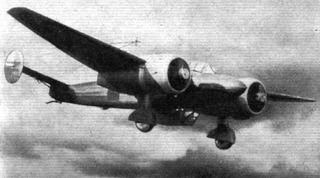The DB-LK was a bomber aircraft designed and built in the USSR in 1939.

The Polikarpov NB was a Soviet twin-engined bomber designed during World War II. Only a single prototype had been built before the program was terminated upon the death of Nikolai Nikolaevich Polikarpov, the head of the aircraft's design bureau, in 1944.

The SNCAC NC.510 was a twin-engine French reconnaissance, army co-operation or advanced training aircraft, built in the late 1930s. Three were built and refined but production orders were not forthcoming.
The Bonomi BS.22 Alzavola was a training motor glider, intended to acquaint capable glider pilots with the characteristics of powered aircraft. The sole example was designed and built in Italy in the late 1930s.
The DFS Sperber Senior was a competition sailplane designed and built in Germany in 1936. During 1937 the sole example visited the United States and scored highest in the US National Soaring Competition.

The Müller G.M.G. II was a German single engine, tandem seat sports monoplane from 1928. Its high wing was unusually mounted.

The Gribovsky G-8 was a single seat sports and training aircraft designed and built in the USSR in the early 1930s.
The Gribovsky G-10 was a single seat sports aircraft designed and built in the USSR in the early 1930s.
The Gribovsky G-15 was a single engine, side-by-side two seat touring aircraft built in USSR in the 1930s. Only one was completed.
The Gribovsky G-22 was a low powered, single seat sports cantilever monoplane, designed and built in the USSR in the mid-1930s. It set at least one class record and flew from 1936 to at least 1940, though only one was completed.
The Gribovsky G-25 was a Russian tandem seat biplane basic trainer built in the late 1930s. It was hoped to minimize unit costs by using a modified automobile engine but the G-25 did not reach production.
The Gribovsky G-26 was a single seat sports aircraft designed for high performance in the USSR in the later 1930s. Only one was built.
The Gribovsky G-27 was a light, economical, twin engined, multi-role aircraft built in the USSR in 1938-9. It did not reach production.
The Gribovsky G-28 was an advanced trainer for trainee fighter pilots, built in the USSR just before the German invasion in 1941. It satisfied VVS testing but changing priorities led to the abandonment of production plans.

The 1923 Feiro I was the first Hungarian designed and built civil transport aircraft, modified in 1925 by an engine change into the Feiru Daru (Crane). Neither was a commercial success.
The S.E.C.A.T.-VI La Mouette or S.E.C.A.T. 60T La Mouette was a French two seat tourer built shortly before the outbreak of World War II.
The SEA.1 was a Belgian, multi-purpose, light twin engine monoplane flown in 1936. Only one was built; it was later converted into a single engine aircraft and used by the military.

The Mauboussin M.112, M-12 or Mauboussin M.XII was originally called the Peyret-Mauboussin PM XII and was renamed when Mauboussin founded his own company in 1931, ending his partnership with Louis Peyret. It was a French, single-engine, two-seat, low cantilever wing touring monoplane. At least six were built.
The Zalewski W.Z.XII Kogutek II was a Polish single-seat sports aircraft. Construction was satarted in 1932 but not completed and flown until 1937. Only one was built.
The Gabriel Śląsk (Silesia) was a Polish light aircraft designed and built by an amateur in the mid-1930s. After two flights the Polish authorities banned further development.
















